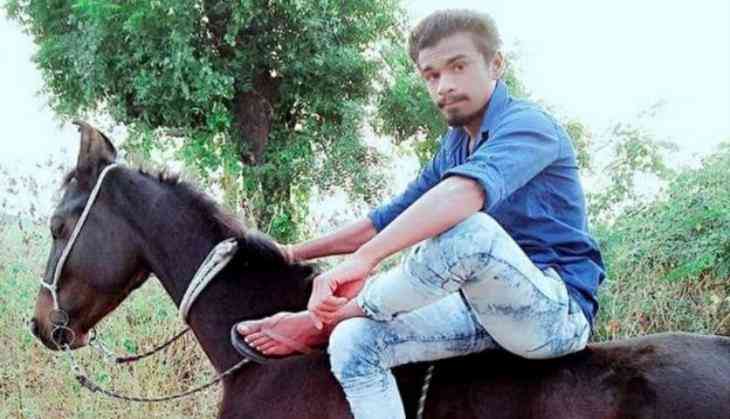Dalit youth killed for riding a horse: Is there a Gujarat Model of violent casteism?

The gruesome killing of a Dalit youth in Bhavnagar district of Gujarat for his “audacity” to own and ride a horse is yet another incident in the ongoing conflict between Dalit assertion and Upper Caste reaction. This is not the first incident in the state whose model of governance is being played up across India and observers feel that this chain of incidents is not likely to to come to an end early.
Twenty one year old Pradip Rathod of Timbi village in Umrala taluka of Bhavnagar district was killed on the evening of 29 March. The murder reportedly followed threats to his father Kalubhai Rathod a week back from the Upper Caste Darbars to get his son to refrain from riding a horse or face dire consequences. The old man had been advised to sell off the horse that had been purchased for Rs 30,000.
Pradip's body was recovered with multiple injuries and a fractured skull from a bush near the village on Thursday night. Those who had threatened his father had told him to tell his son not to indulge in an 'Upper Caste hobby' and sell the horse to a 'proper' (read Upper Caste) person.
Sources say that Kalubhai had responded telling them that when Upper Castes even ride elephants, why couldn't his son ride a horse.
On Thursday Pradip left for the family farm on his horse while Kalubhai was to follow him later through a different route. When the father's numerous calls on his mobile phone went unanswered, Kalubhai got suspicious and a hunt was launched for his son. It was only at night that Pradip's mutilated remains were discovered near a bush. Sources say that three persons have been arrested in the case.
Such atrocities are nothing new in Gujarat where cases have been quite often reported about Dalits being pulled down from horse-backs during wedding procession, being assaulted for sporting a moustache which is believes to be a symbol of Upper Caste masculinity, denied haircuts in village barber shops, not being allowed entry in temples or being allowed or fetch water from public sources etc.
Two cases had made headlines last year when a Dalit youth in Limbodara village of Gandhinagar was allegedly stabbed for supporting a moustache. This attack had followed another reported assault on a couple of Dalit boys in Kalol for the same reason. This had resulted in a massive outrage with people posting a caricature of a moustache on the social websites that went viral. This had been followed by the killing of Dalit youth for watching a Garba in Bhadaniya village of Anand district.
Coming back to the murder in Timbi village, reports say that the Upper Castes in the adjoining villages are not happy with 27 Dalit families getting 300 acres of government land recently following a series of agitations that have followed the Una public flogging incident of 2016.
Taking about the prevailing mindset against the Dalits in the area, Dalit activist Martin Macwan said, “Dalits are on the receiving end in this part. They are helpless even when an Upper Caste barges into their houses to abuse them.” He said that the population of Dalits is low in Bhavnagar district, which adds to their woes.
Even across Gujarat, Dalits have been suffering because they account for only around seven per cent of the population and are widely scattered.
Macwan further pointed, “A disturbing trend that is being witnessed in various cases is that the educated new generation is taking to violent casteism.”
“The Upper Castes continue to believe that they have a birthright over things like owning horses, supporting a moustache and such other symbols of male chauvinism. What is being witnessed is a conflict between Dalit assertion, particularly by the youth, and Upper Caste reaction to it. All the three victims whether in Limbodra, Bhadaniya or Timbi villages were below the age of 25 years,” said a senior political and social observer.
He pointed to two processes at work that are adding to caste enmities. Firstly, the government has failed to provide employment to the educated youth from the non-reserved categories who have been spending a fortune acquiring degrees from private institutions that have rendered them unemployable.
Secondly, the Dalits are also being denied reservation benefits in the name of outsourcing, contractual mode of employment and using pretexts of vertical and horizontal reservations. “In the process, the unemployed upper castes are returning to the villages with the perception that their jobs are being dished out to Dalits. They are now back to consolidating traditional resources like water and land not wanting the Dalits to have a share in them. All this is being further strengthened by the political system as it suits the politicians in polarising votes in the name of caste,” he added.
Incidentally, the murder of the Dalit youth in Timbi comes just a few days after the Supreme Court saying that complaints of atrocities against Scheduled Castes (SC) and Scheduled Tribes (ST) should be dealt with caution. Since then there has been a considerable anger among the Dalits on the issue of 'dilution' of Scheduled Castes and the Scheduled Tribes (Prevention of Atrocities) Act, 1989.
Dalit activist and Vadgam MLA Jignesh Mevani while referring to the killing in Timbi put up a sarcastic comment on Facebook saying, “Dedicated to Apex Court judgment which says Dalits blackmail citizens with POA act.”


